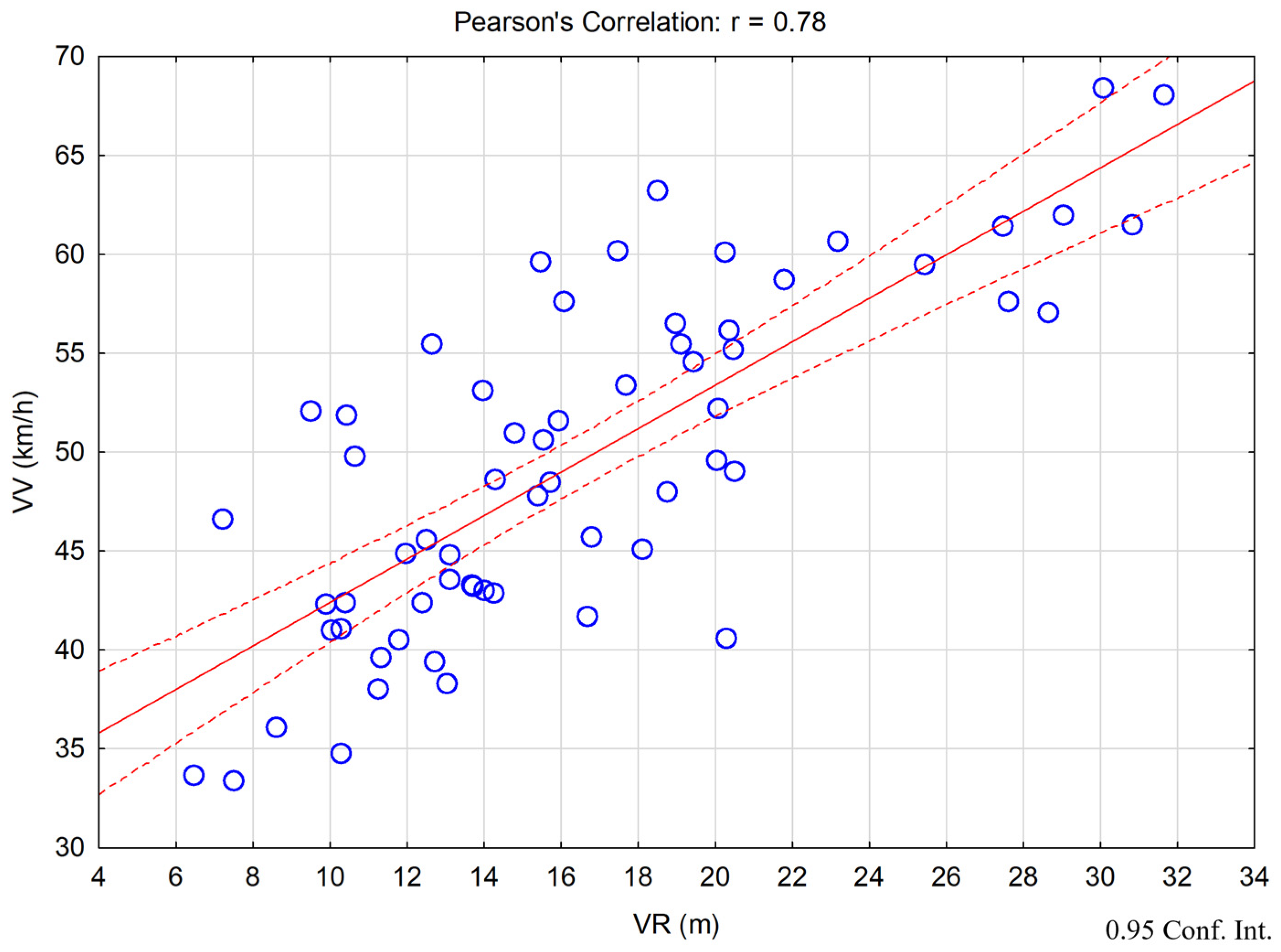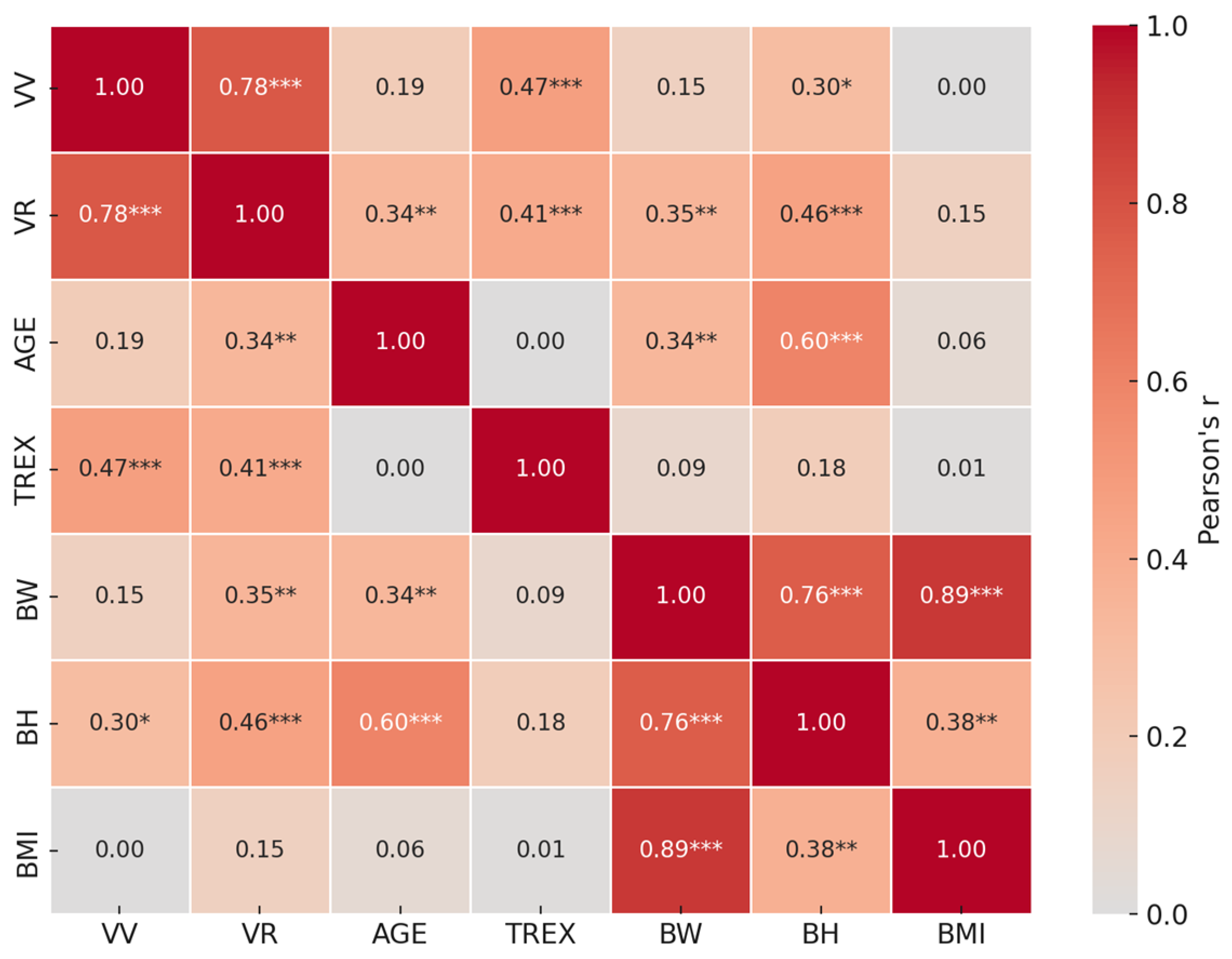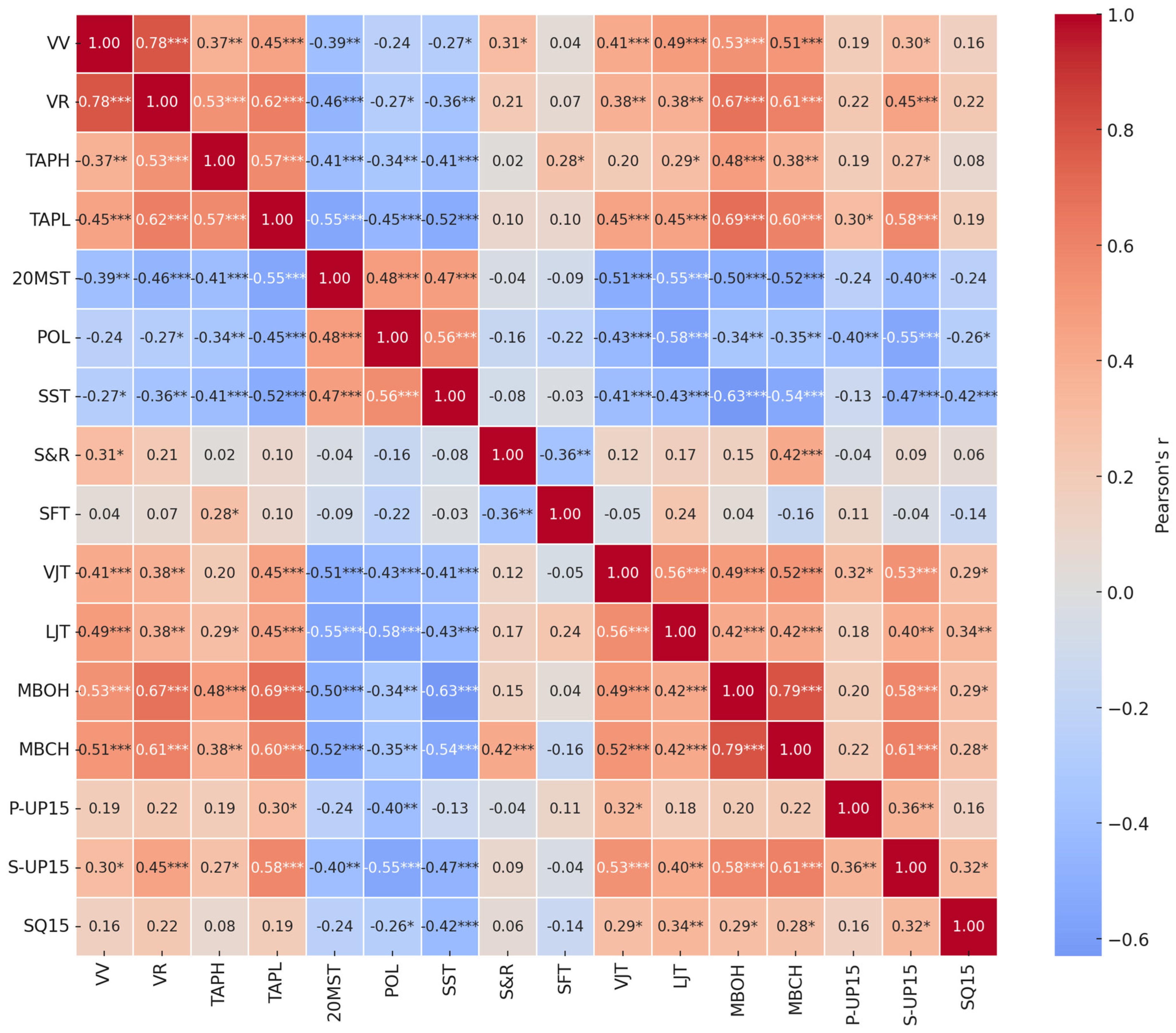The Relationship of Anthropometric Characteristics and Motor Abilities with Vortex Throwing Performance in Young Female Track-and-Field Athletes
Abstract
1. Introduction
2. Materials and Methods
2.1. Participants
2.2. Variables and Measurement Procedures
2.3. Statistical Analysis
3. Results
4. Discussion
Limitations and Strengths
5. Conclusions
Author Contributions
Funding
Institutional Review Board Statement
Informed Consent Statement
Data Availability Statement
Acknowledgments
Conflicts of Interest
References
- Antekolović, L.; Marton, J.; Bošnjak, G. Razlike u Rezultatu Bacanja Vortexa Kod Djece 10 do 12 Godina Nakon Eksperimentalnog Programa Učenja Analitičkom i Sintetičkom Metodom. (Differences in Vortex Throwing Results Among Children Aged 10–12 Years After an Experimental Learning Program Using the Analytical and Synthetic Methods) In: 30 Ljetna Škola Kineziologa RH, Kineziologija u Europi, Izazovi Promjena. 2022, pp. 804–810. Available online: www.hrks.hr (accessed on 22 August 2025).
- Jakovljević, V.; Bošnjak, T. Povezanost rezultata bacanja vortexa kugle i koplja. (Correlation between the results of vortex, shot put, and javelin throwing). Glas. Fak. Fizičkog Vaspitanja Sport. (engl. Gaz. Fac. Phys. Educ. Sports) 2008, 4, 69–75. [Google Scholar]
- Tešanović, G.; Bošnjak, G. Primjena vortexa kao zamjenskog rekvizita u trenažnom procesu mladih bacača koplja. (The use of the vortex as a substitute implement in the training process of young javelin throwers). Sport Ekspert 2009, 2, 18–21. [Google Scholar]
- Pokrajčić, V.; Čerkez Zovko, I.; Rezić, M. Application of vortex as auxiliary prop in javelin throw technique training at kinesiology student. Sportlogia 2019, 15, 73–80. [Google Scholar] [CrossRef]
- Bartlett, R.M.; Best, R.J. The biomechanics of javelin throwing: A review. J. Sports Sci. 1988, 6, 1–38. [Google Scholar] [CrossRef]
- Jalalabadi, Y.; Mohammadi, S.; Amiri, F.N. Analyzing, investigating and calculating the optimum mode of the parameters affecting the record of the javelin throw including the initial velocity, initial angle, and initial height of throw. Turk. J. Kinesiol. 2019, 5, 1–14. [Google Scholar] [CrossRef]
- Morris, C.; Bartlett, R. Biomechanical factor critical for performance in men’s javelin throw. Sports Med. 1996, 21, 438–446. [Google Scholar] [CrossRef]
- Gromeier, M.; Koester, D.; Schack, T. Gender differences in motor skills of the overarm throw. Front Psychol. 2017, 8, 212. [Google Scholar] [CrossRef]
- Zaras, N.; Stasinaki, A.-N.; Terzis, G. Biological determinants of track and field throwing performance. J. Funct. Morphol. Kinesiol. 2021, 6, 40. [Google Scholar] [CrossRef]
- Žuvela, F.; Borović, S.; Foretić, N. The correlation of motor abilities and javelin throwing results depends on the throwing technique. Facta Univ. Phys. Educ. Sport 2011, 9, 219–227. [Google Scholar]
- Ivanović, M. Relations between motor abilities and javelin throw results of adolescents. Sport Sci. 2009, 2, 84–90. [Google Scholar]
- Maszczyk, A.; Roczniok, R.; Pietraszewski, P.; Stanula, A.; Zając, A.; Gołaś, A. Time series approach to athletes motor potential. Pol. J. Sport Tour. 2012, 19, 103–106. [Google Scholar] [CrossRef]
- Stanković, D.; Joksimović, A.; Raković, A.; Piršl, D. Influence of some motor abilities on javelin throw succes. Fizička Kult. 2010, 38, 95–97. [Google Scholar]
- Milanović, D.; Harasin, D. Vrednovanje komponenata treniranosti atletičara bacača. (Evaluation of the components of fitness in track-and-field throwers). In 13 Ljetna Škola Kineziologa RH “Vrednovanje u Području Edukacije, Sporta i Sportske Rekreacije”; Findak, V., Ed.; Hrvatski Kineziološki Savez: Zagreb, Croatia, 2004; pp. 149–154. [Google Scholar]
- Coh, M.; Embersic, D.; Zvan, M. Correlation between anthropometric characteristicd and competitive results of elite junior javelin throwers. In Biomechanics Symposia—19 International Symposium on Biomechanics in Sports; Blackwell, J., Ed.; University of San Francisco: San Francisco, CA, USA, 2001; pp. 90–93. [Google Scholar]
- Kuznetsova, Z.M.; Kuznetsov, S.A.; Ovchinnkov, Y.D.; Golovko, P.V. Analysis of the morphological-functional indices connection degree in throwing among athletes. Russ. J. Phys. Educ. Sport 2018, 13, 44–50. [Google Scholar]
- Tešanović, G.; Jakovljević, V.; Bošnjak, G. Relations between some anthropometric dimension with the results achieved in shot put and javelin throw. Fiep Bull. 2013, 83, 364–367. [Google Scholar]
- Gromeier, M.; Schack, T.; Koester, D. Effects of Age and Expertise on Mental Representation of the Throwing Movement Among 6- to 16-Year-Olds. Front. Psychol. 2022, 13, 799316. [Google Scholar] [CrossRef] [PubMed]
- Lloyd, R.S.; Oliver, J.L.; Faigenbaum, A.D.; Howard, R.; Croix, M.B.D.S.; Williams, C.A.; Best, T.M.; Alvar, B.A.; Micheli, L.J.; Thomas, D.; et al. Long-term athletic development-Part 1: A pathway for all youth. J. Strength Cond. Res. 2015, 29, 1439–1450. [Google Scholar] [CrossRef] [PubMed]
- Aleksovskal, L.P.; Pop-Petrovski, V. Influence of some motoric and anthropometric variables on the result in throwing vortex at 13 year old students. Res. Kinesiol. 2012, 40, 43. [Google Scholar]
- Pavić, D.; Ljubičić, H.; Zagorac, N.; Čavala, M.; Jukić, J. Utjecaj nekih motoričkih sposobnosti i morfoloških karakteristika na rezultat u bacačkim i skakačkim disciplinama kod ispitanica kadetskog uzrasta. (Effects of selected motor abilities and morphological characteristics on performance in throwing and jumping events in cadet-age female participants). In Efekti Primene Fizičke Aktivnosti na Antropološki Status Dece, Omladine i Odraslih; Savović, B., Mandić, R., Radenović, S., Eds.; Univerzitet u Beogradu, Fakultet Sporta i Fizičkog Vaspitanja: Beograd, Serbia, 2016; pp. 108–112. [Google Scholar]
- Krzyszkowski, J.; Kipp, K. Prediction of throwing distance in the men’s and women’s javelin final at the 2017 IAAF world championships. J. Sports Sci. 2021, 39, 1055–1059. [Google Scholar] [CrossRef]
- Pavlović, R. Biomechanical analysis in athletics: The influence of kinematic parameters on the results of javelin throw of elite athletes. Swed. J. Sci. Res. 2020, 7, 1–11. [Google Scholar]
- Saratlija, P.; Zagorac, N.; Babić, V. Influence of Kinematic Parameters on Result Efficiency in Javelin Throw. Coll Antropol. 2013, 37, 31–36. [Google Scholar]
- Shaaban, E.E.; Hassan, A. Development of the Biomechanical Simulation System to Evaluate Physical Variables in Javelin Throw. J. Phys. Act. Sport 2018, 1, 3–10. [Google Scholar]
- Neljak, B.; Novak, D.; Sporiš, G.; Višković, S.; Markuš, D. CROFIT Norme: Metodologija Vrjednovanja Kinantropoloških Obilježja Učenika u TZK (CROFIT Norms: Methodology for Evaluating Students’ Kinanthropological Characteristics in Physical Education), 1st ed.; Neljak, B., Ed.; Kineziološki fakultet Sveučilišta u Zagrebu: Zagreb, Croatia, 2012. [Google Scholar]
- Kurelić, N.; Momirović, K.; Stojanović, J.Š.; Radojević, Đ.; Viskić-Štalec, N. Struktura i Razvoj Morfoloških i Motoričkih Dimenzija Omladine. (Structure and Development of the Morphological and Motor Dimensions of Youth), 1st ed.; Institut za Naučna Istraživanja Fakulteta za Fizičko Vaspitanje Univerziteta u Beogradu: Beograd, Serbia, 1975. [Google Scholar]
- Radcliffe, J.C.; Farentinos, R.C. Plyometrics, 1st ed.; Gopal d.o.o.: Zagreb, Croatia, 2009. [Google Scholar]
- Villalón-Gasch, L.; Jimenez-Olmedo, J.M.; Penichet-Tomas, A.; Sebastia-Amat, S. Concurrent Validity and Reliability of Chronojump Photocell in the Acceleration Phase of Linear Speed Test. Appl. Sci. 2025, 15, 8852. [Google Scholar] [CrossRef]
- Bany, W.; Nyrć, M.; Lopuszanska-Dawid, M. Morphological and Functional Asymmetry Among Competitive Female Fencing Athletes. Appl. Sci. 2025, 15, 8020. [Google Scholar] [CrossRef]
- Stalker, R. Stalker Pro II Owner’s Manual; Applied Concepts, Inc.: Plano, TX, USA. Guidance on Aligning Radar with Target Motion and Cosine-Angle Considerations; Peak (“Release”) Speed Capture. 2016. Available online: https://www.stalkerradar.com/sportsradar/documents/011-0093-00_Pro_II_operator_manual.pdf (accessed on 3 October 2025).
- de Salles, P.; Vasconcellos, F.; de Salles, G.; Fonseca, R.; Dantas, E. Validity and reproducibility of the sargent jump test in the assessment of explosive strength in soccer players. J. Hum. Kinet. 2012, 33, 115–121. [Google Scholar] [CrossRef]
- Petz, B.; Kolesarić, V.; Ivanec, D. Petzova Statistika—Osnovne Statističke Metode za Nematematičare. (Petz’s Statistics—Basic Statistical Methods for Non-Mathematicians.), 2012th ed.; Matešić, K., Ed.; Naklada Slap: Zagreb, Croatia, 2012. [Google Scholar]
- Schober, P.; Boer, C.; Schwarte, L.A. Correlation coefficients: Appropriate use and interpretation. Anesth. Analg. 2018, 126, 1763–1768. [Google Scholar] [CrossRef]
- Hussain, I.; Bari, M.A. Javelin Throwing Technique: A Biomechanical Study. 2012, Volume 3. Available online: www.iiste.org (accessed on 22 August 2025).
- Putnam, C.A. Sequential motions of body segments in striking and throwing skills: Descriptions and explanations. J. Biomech. 1993, 26 (Suppl. 1), 125–135. [Google Scholar] [CrossRef] [PubMed]
- Makino, M.; Nakayama, K.; Ando, Y.; Tauchi, K. Kinematic Contribution to Javelin Velocity at Different Run-Up Velocities in Male Athletes. J. Hum. Kinet. 2023, 89, 43–52. [Google Scholar] [CrossRef] [PubMed]



| VARIABLES | M | Min | Max | SD |
|---|---|---|---|---|
| SAMPLE OF RESPONDENTS | ||||
| Age (years) | 9.76 | 8.83 | 10.92 | 0.60 |
| Training experience (months) | 16.46 | 1.00 | 48.00 | 12.82 |
| ANTHROPOMETRIC CHARACTERISTICS | ||||
| Body weight (kg) | 33.65 | 23.70 | 58.70 | 7.20 |
| Body height (cm) | 140.85 | 127.00 | 160.30 | 7.17 |
| Body mass index (kg/m2) | 16.83 | 13.27 | 25.84 | 2.46 |
| VARIABLES | M | Min | Max | SD |
|---|---|---|---|---|
| THROWING PERFORMANCE | ||||
| Vortex release velocity (km/h) | 49.53 | 33.40 | 68.40 | 8.64 |
| Vortex throwing distance/result (m) | 16.49 | 6.47 | 31.64 | 6.15 |
| MOTOR ABILITIES | ||||
| Hand tapping test (n/15 s) | 22.75 | 18.00 | 38.00 | 3.51 |
| Leg tapping test (n/15 s) | 19.71 | 15.00 | 25.00 | 2.22 |
| The 20 m sprint with a standing start (s) | 4.09 | 3.22 | 4.97 | 0.34 |
| The polygon backwards test (s) | 18.93 | 12.47 | 31.00 | 4.39 |
| Side-step test (s) | 11.51 | 8.52 | 15.13 | 1.36 |
| Sit and reach flexibility test (cm) | 55.27 | 23.00 | 84.00 | 11.66 |
| Shoulder standing flexibility test with stick (cm) | 51.02 | 13.00 | 82.00 | 14.38 |
| Standing vertical jump test (cm) | 30.38 | 19.00 | 43.00 | 5.46 |
| Standing long jump test (cm) | 155.67 | 105.00 | 194.00 | 21.05 |
| Standing overhead medicine ball throw/1 kg (m) | 5.81 | 3.73 | 10.05 | 1.47 |
| Standing chest medicine ball launch/1 kg (m) | 5.71 | 3.13 | 8.19 | 1.08 |
| Push-up test (n/15 s) | 10.05 | 1.00 | 18.00 | 3.78 |
| Sit-up test (n/15 s) | 11.24 | 7.00 | 16.00 | 2.00 |
| Squat test (n/15 s) | 15.10 | 11.00 | 17.00 | 1.29 |
| Vortex Throwing Velocity | |||
|---|---|---|---|
| Variable | β | b | p |
| TAPH | 0.16 | 0.40 | 0.25 |
| TAPL | 0.02 | 0.08 | 0.90 |
| 20MST | 0.00 | −0.09 | 0.98 |
| POL | 0.13 | 0.26 | 0.42 |
| SST | 0.16 | 1.05 | 0.33 |
| SFT | −0.06 | −0.04 | 0.64 |
| VJT | 0.05 | 0.08 | 0.73 |
| LJT | 0.39 | 0.16 | 0.02 |
| MBOH | 0.28 | 1.66 | 0.19 |
| MBCH | 0.14 | 1.15 | 0.46 |
| P-UP15 | 0.06 | 0.14 | 0.62 |
| SQ15 | −0.04 | −0.26 | 0.76 |
| R | 0.66 | ||
| R2 | 0.43 | ||
| Adjusted R2 | 0.30 | ||
| p | 0.01 | ||
| Votrex Throwing Distance | |||
|---|---|---|---|
| Variable | β | b | p |
| TAPH | 0.22 | 0.39 | 0.08 |
| TAPL | 0.16 | 0.46 | 0.29 |
| 20MST | −0.09 | −1.61 | 0.51 |
| POL | 0.11 | 0.15 | 0.51 |
| SST | 0.16 | 0.73 | 0.27 |
| SFT | 0.04 | 0.02 | 0.73 |
| VJT | 0.00 | 0.00 | 1.00 |
| LJT | 0.06 | 0.02 | 0.65 |
| MBOH | 0.39 | 1.64 | 0.04 |
| MBCH | 0.07 | 0.41 | 0.72 |
| P-UP15 | 0.04 | 0.07 | 0.72 |
| S-UP15 | 0.07 | 0.22 | 0.63 |
| S&R | 0.13 | 0.07 | 0.32 |
| R | 0.76 | ||
| R2 | 0.58 | ||
| Adjusted R2 | 0.46 | ||
| p | 0.001 | ||
Disclaimer/Publisher’s Note: The statements, opinions and data contained in all publications are solely those of the individual author(s) and contributor(s) and not of MDPI and/or the editor(s). MDPI and/or the editor(s) disclaim responsibility for any injury to people or property resulting from any ideas, methods, instructions or products referred to in the content. |
© 2025 by the authors. Licensee MDPI, Basel, Switzerland. This article is an open access article distributed under the terms and conditions of the Creative Commons Attribution (CC BY) license (https://creativecommons.org/licenses/by/4.0/).
Share and Cite
Strukar, S.; Harasin, D.; Gilić, B. The Relationship of Anthropometric Characteristics and Motor Abilities with Vortex Throwing Performance in Young Female Track-and-Field Athletes. Appl. Sci. 2025, 15, 11381. https://doi.org/10.3390/app152111381
Strukar S, Harasin D, Gilić B. The Relationship of Anthropometric Characteristics and Motor Abilities with Vortex Throwing Performance in Young Female Track-and-Field Athletes. Applied Sciences. 2025; 15(21):11381. https://doi.org/10.3390/app152111381
Chicago/Turabian StyleStrukar, Stjepan, Dražen Harasin, and Barbara Gilić. 2025. "The Relationship of Anthropometric Characteristics and Motor Abilities with Vortex Throwing Performance in Young Female Track-and-Field Athletes" Applied Sciences 15, no. 21: 11381. https://doi.org/10.3390/app152111381
APA StyleStrukar, S., Harasin, D., & Gilić, B. (2025). The Relationship of Anthropometric Characteristics and Motor Abilities with Vortex Throwing Performance in Young Female Track-and-Field Athletes. Applied Sciences, 15(21), 11381. https://doi.org/10.3390/app152111381







